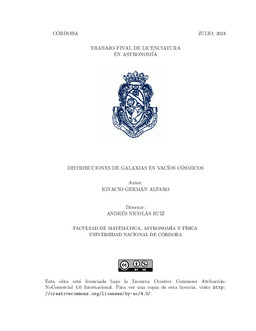| dc.contributor.advisor | Ruiz, Andrés Nicolás, dir. | |
| dc.contributor.author | Alfaro, Ignacio Germán | |
| dc.date.accessioned | 2018-07-25T14:07:44Z | |
| dc.date.available | 2018-07-25T14:07:44Z | |
| dc.date.issued | 2018-07 | |
| dc.identifier.uri | http://hdl.handle.net/11086/6466 | |
| dc.description | Tesis (Lic. en Astronomía)--Universidad Nacional de Córdoba, Facultad de Matemática, Astronomía, Física y Computación, 2018. | es |
| dc.description.abstract | En este trabajo se estudia la función de correlación bipuntual de galaxias dentro de las grandes regiones subdensas de la estructura en gran escala del Universo, a las cuales denominamos voids. En primer instancia se miden las correlaciones en un catálogo sintético derivado de utilizar el modelo semi-analı́tico de Guo et al. (2011) en la simulación numérica Millennium. Los resultados obtenidos muestran que el pasaje entre el espacio real y el espacio de redshift tiene un efecto mucho menor en las correlaciones medidas en la distribución de galaxias dentro de los voids que en las obtenidas para el catálogo completo; esto implica que las primeras se encuentran menos afectadas por las distorsiones que provocan las velocidades peculiares de las galaxias. Para disminuir aun más la diferencia entre las correlaciones, se construyó un perfil de velocidad radial media en función de la distancia al centro del void y se lo restó a las velocidades peculiares de las galaxias que pueblan las regiones subdensas. Posteriormente se buscó aplicar los mismos procedimientos a datos observacionales extraı́dos del SDSS-DR7, obteniendo resultados consistentes con los de los datos sintéticos. | es |
| dc.description.abstract | The aim of this work is to study the two-point correlation function inside the large
subdense region of the large-scale structure in the universe known as voids. In the first instance the correlations are measured in a synthetic cataloge derived from the use of the semi-analytic of Guo et al. (2011) in the Millennium numerical simulation.
The results obtained show that the passage between the real space and the redshift space have a much smaller affect in the correlations measured in the distribution of galaxies inside the voids than in the distribution of galaxies inside the voids than in the ones obtained for the complete cataloge. This implies that the first ones are less
affected by the distortions provoked by the peculiar velocities of galaxies. In the order to reduce even more the difference between the correlations, a profile of the average radial velocity was created in function of the center of void’s distance, and was substracted
from the peculiar velocities of the galaxies in the subdense region. After this, the same procedures were applied in the observational data extracted from the SDSS-DR7 and the results obtained were consistent with the synthetic data. | en |
| dc.language.iso | spa | es |
| dc.rights | Attribution-NonCommercial 4.0 International | en |
| dc.rights.uri | https://creativecommons.org/licenses/by-nc/4.0/ | en |
| dc.subject | Sistemas estelares | es |
| dc.subject | Stellar systems | es |
| dc.subject.other | Estructura en gran escala | es |
| dc.subject.other | Voids | |
| dc.subject.other | Función de correlación | es |
| dc.subject.other | Galaxias | es |
| dc.subject.other | Espacio real | es |
| dc.subject.other | Espacio de Redshift | es |
| dc.title | Distribuciones de galaxias en vacíos cósmicos | es |
| dc.type | bachelorThesis | en |





